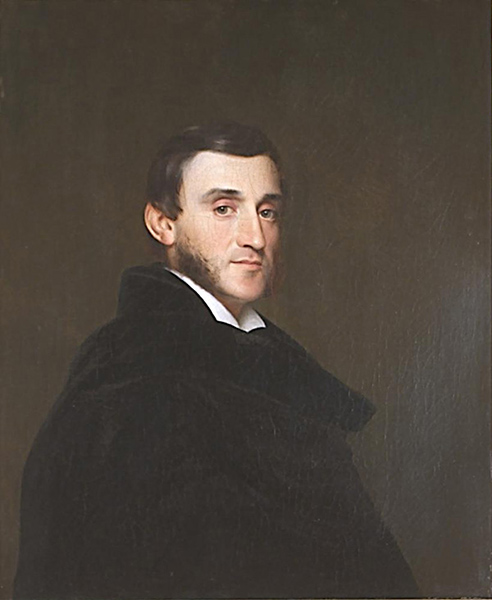Introduction
I thought it appropriate to publish here the story of the role played by a member of Brown University’s founding family in the dramatic events that took place in the Papal States during the revolution of 1848-1849.1A shorter, earlier version of this presentation was given at the University of Bologna on June 13, 2017 as part of the celebration of the 35th anniversary of the Brown University partnership with the University of Bologna. My thanks to Prof. Francesco Ubertini, rector of the University of Bologna, for hosting this event, and to my colleague Massimo Riva for his role in its organization.

It is the story of the American consul to Rome, Nicholas Brown, the only person representing the United States in Rome at the time of the assassination of Pellegrino Rossi and the flight of Pius IX to Gaeta. The story has not previously been told, and is made possible by the existence of Brown’s papers from his time in Rome in the archives of Brown University. A portion of these were given to the University in 1927-1928 and soon catalogued, although their existence has to date been little known to Italian scholars of the Risorgimento.2Koopman, H.L., Librarian’s Annual Report for 1927/28, Brown University, Providence, RI. Indeed, it turns out that a significant portion of the Nicholas Brown’s papers left to Brown University were unknown to the university library as well. Having been separated at some point from the rest of the archive, they had been deposited in the Annmary Brown Memorial, uncatalogued, and only came to light in 2017.
Before turning to the story of Nicholas Brown and the Roman revolution of 1848-1849, let me begin by briefly providing a little background on who Nicholas Brown was, and his family link to Brown University.
For Brown family aficionados, the Nicholas Brown whose exploits I am chronicling here might called Nicholas Brown III. His grandfather Nicholas Brown, together with his grandfather’s younger brothers, established the family business in Rhode Island. Involved in major trans-Atlantic commerce (including the slave trade), they were among Rhode Island’s wealthiest and most prominent citizens. In 1764, together with his brothers, Nicholas Brown became one of the founding trustees of what was at the time known as the College of Rhode Island, the seventh university to be established in the American colonies. That original Nicholas Brown’s son, Nicholas Brown II, born in 1769, graduated from the new college and joined the family business. It would be his legendary gift of $5000 that would lead the College to change its name in his honor, and so the College of Rhode Island became Brown University. Nicholas III, the eldest son of this Nicholas, was born in Providence in 1792, and he too went to Brown University. In 1845, when Brown was fifty-two years old, President James K. Polk named him the United States consul to Rome. At the time the U.S. had no diplomatic relations with the Papal States, and so there was no ambassador.3The same was the case with Great Britain, as Protestant-majority countries generally opposed giving diplomatic recognition to the state ruled by the pope.
Nicholas Brown (I dispense with the III from this point) is in some ways a classic American figure. Independently wealthy and a member of New England’s elite, he fancied himself a champion of what he took to be core American Enlightenment, republican values. Yet before attaining his post as consul in Rome, he had achieved little in life. “Moody and rancorous,” as the Brown family historian describes him, he “was an unusually angry, embittered, and ungrateful man.” Nicholas had been excluded from the family business by his father who found him unsuitable for it, and had spent much of his life bickering with his father for more money. When his father died in 1841, excluding Nicholas from the management of the family business, Nicholas was further enraged. In a letter the following year, he claimed that he would have to pawn his watch for fifty dollars, adding, “I did hope that on his death whether I lived here or elsewhere, I should no longer be compelled to live in the miserably straightened manner I had done for years previous to his exit.”4Brown 2017, p. 322.
Before I turn to Brown’s exploits in Rome, let me first mention that Nicholas’s youngest daughter, Caroline, married an Italian diplomat, Paolo Bajnotti, in 1876. Following her death in 1896, Bajnotti had a 95-foot brick bell tower built on the Brown campus in her honor. This is not the only major sign of Brown’s daughters that can still be found today on the campus. His other daughter, Annmary, had married a Civil War hero, Rush Hawkins, a successful lawyer and avid book and art collector. Following her death, Hawkins had a granite, mausoleum-like, windowless building in which Annmary is entombed built alongside the Brown University campus. Following his own death, he too was entombed there, having willed much of his book and art collection to what became known as the Annmary Brown Memorial.5Brown 2017, p. 329.
It was in that sepulchral building that, in 2017, a major portion of Nicholas Brown’s papers, which Rush Hawkins had put into a scrapbook, came to light.
Yet the most important addition of Nicholas Brown’s family to the Brown University campus came not from his daughters, but from his younger brother, John Carter, who stayed home to run the family business while Nicholas gallivanted around Europe. John Carter Brown’s true passion was not business but collecting old books. The John Carter Brown library, one of the most important research libraries in the world for the early contacts between Europe and the Americas, now stands at the center of the Brown campus.6According to Sylvia Brown’s history (2017, p. 324), the initial core of John Carter Brown’s old book collection came from books that Nicholas had bought in Europe on an earlier trip and had sold to his brother when he needed money.


